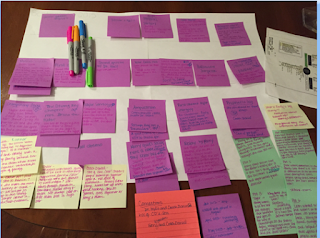Over the last couple of years of working as our district's Writing Coordinator and instructional coach, I have admired the work of our kindergarten teachers; I have come to believe that no one works harder than kindergarten teachers in the first few weeks of the year. Their job reminds me of herding cats. While I could find instructional practices to share in any of the classrooms, two of the teachers have done an especially amazing job of integrating technology into their teaching. We are fortunate in that each kindergarten classroom has five iPads, but we are also fortunate to have teachers who have invested so much energy into using them purposely.
Last year, by the time I visited Katie Bristol's kindergarten class, iPads were already a seamless part of writing workshop. This year, at a workshop I presented for several of our primary teachers, we were all interested to hear how Katie lays the groundwork for the rest of the year's use of iPads. She has invited me into her classroom every day this week, she has provided me with her lesson plan, and she has been eager to share the introductory work with all who are interested. So, here is a peek into Katie's introduction of iPads to her kindergarten class.
Each session began with a whole group lesson. On Day 1, the whole group lesson was described as such:
Followed by small group work and individualized practice opportunities:
Small Group Work:
- With each small group, remind the students first of how to properly handle the iPad by using 2 hands and keeping it on their laps or on a table.
- Next have the students sequence the pictures to show how to wake the iPad up.
- Once students have completed the picture sequence correctly, distribute the iPads. Go through the procedure of waking the iPad up, one step at a time while the students follow along.
- If the students complete the guided practice successfully, put the iPads to sleep and have them try once more on their own.
- Repeat the process above (sequencing pictures, guided practice, independent practice) using the procedure of putting the iPad to sleep.
Sitting at a kidney-shaped table gave her plenty of opportunities to individualize her instruction and make sure that all students were learning how to perform basic operations with the iPads, breaking the task of taking pictures down into kindergarten-sized steps.
During these sessions, Katie worked with four or five students for two to four minutes, giving them just the amount of time that they needed to practice the skill of the day.
The four day mini-unit consisted of:
- Day 1: Teaching students hold the iPad, turn it on, and put it to sleep.
- Day 2: Teaching students to build on their skills and open and close an app
- Day 3: Teaching students to continue to build their skills by practicing the previously taught ones and adding on picture taking using the camera app. Katie emphasized the following criteria for picture taking:
1) nothing important is cut out
2) it is straight and
3) there is an appropriate amount of background or extra space around the focal object (i.e. not too zoomed out)
It was so much fun to watch how seriously these students took their picture-taking!
- Finally, on Day 4, the students had a chance to practice their picture taking skills in order to make an alphabet book. An alphabet book was chosen as the format for this book because it ties in nicely in kindergarten-- both within their reading work learning about different types of books and their future writing work of labeling pictures. Other book genres/formats may be chosen based on classroom needs. The important part is that students are taking pictures for a purpose, not just playing with the camera. Katie used a pre-made template in Book Creator in order to make the book with her students. Here is a sample of some of the pages, with the pictures contributed by students on iPads:
As Katie shared in her description of the book, "This book can then be printed and added to the classroom library. It can also be emailed out to parents as an ePub or pdf."
I'm hoping to be able to continue to share some of the work that Katie does with her students. Now that they all understand the basic and important function of taking pictures with the iPad, she'll move on to teach them how to make their own books as she introduces them through various writing genres throughout the year.
Happy Writing,


























